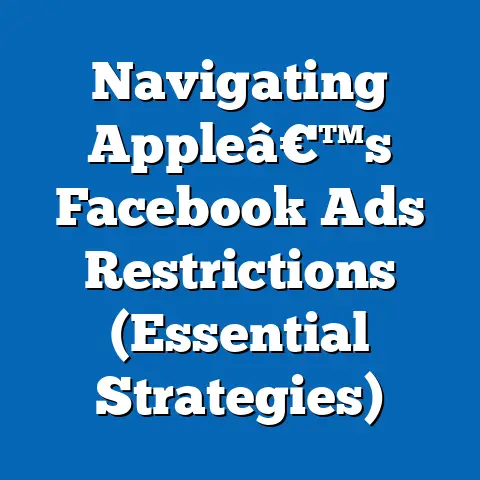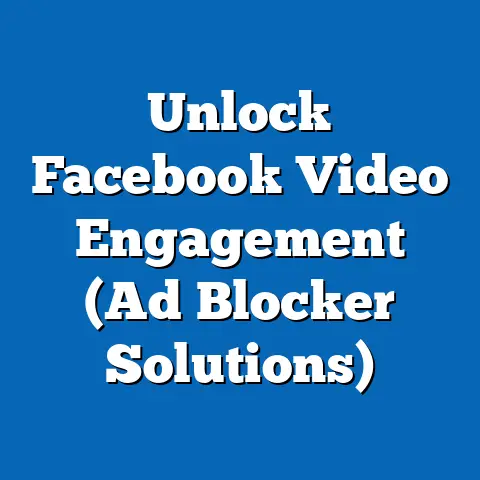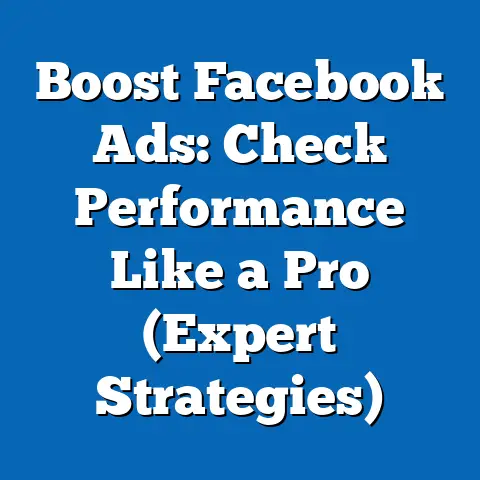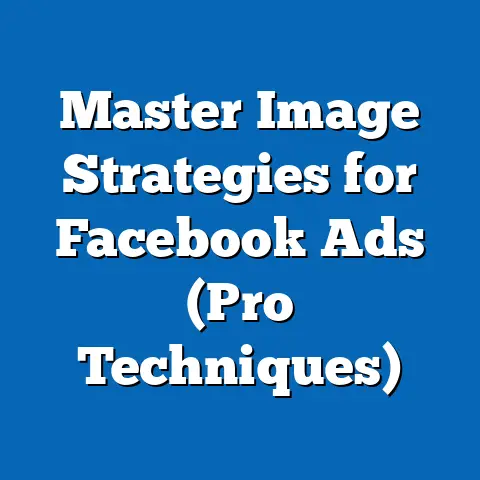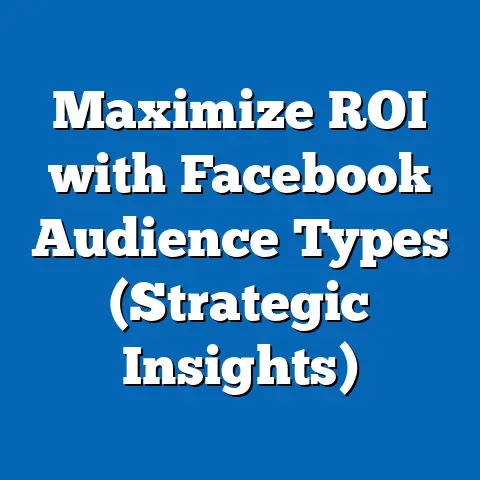Unlocking fb ad Performance (Expert Insights Revealed)
Unlocking FB Ad Performance: Expert Insights Revealed
Warning: The world of Facebook advertising is not for the faint-hearted. With over 2.9 billion monthly active users and an ever-evolving algorithm, the stakes are high, and the competition is fierce. If you’re not equipped with the right knowledge and strategies, your ad spend could vanish into the void, yielding little to no return on investment.
Facebook advertising, when done right, is a powerhouse. It’s a direct line to your ideal customer, a chance to build brand awareness, and a proven pathway to sales. But let’s be honest, many businesses treat it like throwing spaghetti at the wall – hoping something sticks. They boost a post, cross their fingers, and then wonder why their money disappears faster than a free donut in an office meeting.
From understanding the intricate ecosystem of Facebook’s advertising platform to crafting compelling ad content that stops the scroll, we’ll cover it all. We’ll explore the key metrics you absolutely must track, the targeting options that can laser-focus your reach, and the budgeting and bidding strategies that will maximize your ROI.
My goal is simple: to equip you with the knowledge and confidence to navigate the complexities of Facebook advertising and unlock its true potential for your business. So, grab a coffee, settle in, and let’s get started!
Understanding Facebook’s Advertising Ecosystem
Think of Facebook’s advertising platform as a complex, yet incredibly powerful, machine. To truly master it, you need to understand its inner workings, its various components, and how they all interact. It’s not enough to just “boost” a post and hope for the best. You need a strategic understanding of the entire ecosystem.
The Core Components: Ad Manager, Audience Insights, and the Bidding Process
- Ad Manager: This is your control center. It’s where you create, manage, and analyze your ad campaigns. Think of it as the cockpit of your advertising plane. From here, you can define your target audience, set your budget, choose your ad placements, and track your performance. The Ad Manager has evolved significantly over the years, and it’s constantly being updated with new features and functionalities. I remember when it was a much simpler beast, but the increased complexity has also brought increased power and precision.
- Audience Insights: This is where you dig deep into the demographics, interests, and behaviors of your target audience. It’s like having a direct line to the collective consciousness of Facebook users. You can use Audience Insights to identify potential customer segments, understand their preferences, and tailor your ad messaging accordingly. I’ve used Audience Insights to uncover hidden interests and demographics that I never would have considered otherwise, leading to some of my most successful campaigns.
- The Bidding Process: This is the engine that drives the entire system. Facebook operates on an auction-based system, where advertisers bid against each other to show their ads to specific users. The highest bidder doesn’t always win, though. Facebook also considers the quality and relevance of your ad, as well as its estimated action rate (how likely users are to engage with your ad). Understanding the bidding process is crucial for optimizing your ad spend and ensuring that you’re not overpaying for your impressions. I’ve seen campaigns where a slightly lower bid, combined with a higher quality ad, actually outperformed campaigns with much larger budgets.
Decoding Facebook’s Algorithm: Engagement, Relevance, and the Auction System
Facebook’s algorithm is a constantly evolving beast, and trying to keep up with its changes can feel like chasing a ghost. However, at its core, the algorithm is designed to prioritize user experience. Facebook wants to show users content that they find engaging, relevant, and valuable.
- Engagement: Ads that generate high levels of engagement (likes, comments, shares, clicks) are rewarded by the algorithm. This tells Facebook that your ad is resonating with users and providing value.
- Relevance: Facebook assesses the relevance of your ad to the target audience. This is based on factors like the ad copy, visuals, and targeting options. The more relevant your ad is, the more likely it is to be shown to the right people.
- The Auction System: As I mentioned earlier, Facebook operates on an auction-based system. However, it’s not just about who has the highest bid. Facebook also considers the quality and relevance of your ad, as well as its estimated action rate. This means that even if you have a smaller budget, you can still win the auction if your ad is highly engaging and relevant to the target audience.
Leveraging Data Analytics for Effective Ad Placement
Facebook is a data goldmine. It has access to a vast amount of information about its users, including their demographics, interests, behaviors, and online activity. By leveraging this data, you can create highly targeted ad campaigns that reach the right people at the right time.
- Demographic Targeting: Target users based on age, gender, location, education, and other demographic factors.
- Interest-Based Targeting: Target users based on their interests, hobbies, and passions.
- Behavioral Targeting: Target users based on their online behavior, such as their purchase history, website visits, and app usage.
- Custom Audiences: Create custom audiences based on your existing customer data, such as email lists or website visitors.
- Lookalike Audiences: Create lookalike audiences based on your custom audiences. This allows you to reach new users who share similar characteristics with your existing customers.
I’ve found that combining these targeting options often yields the best results. For example, instead of just targeting “small business owners,” you could target “small business owners who are interested in digital marketing and have visited your website in the past 30 days.” This level of precision can significantly improve your ad performance.
Key Takeaway: Understanding the Facebook advertising ecosystem is crucial for success. Take the time to learn about the various components, how the algorithm works, and how to leverage data analytics to create highly targeted ad campaigns.
Key Metrics to Track for Ad Performance
Okay, let’s talk numbers. In the world of Facebook advertising, data is your best friend. It tells you what’s working, what’s not, and where you need to make adjustments. But with so many metrics available, it can be overwhelming to know which ones to focus on.
I’ve learned over the years that focusing on the right metrics is far more important than tracking every metric. Here are the essential metrics that I believe every Facebook advertiser should be tracking:
Defining Essential Metrics: CTR, Conversion Rate, CPA, and ROAS
- Click-Through Rate (CTR): This is the percentage of people who see your ad and click on it. It’s a measure of how engaging and relevant your ad is to the target audience. A high CTR indicates that your ad is capturing attention and enticing users to learn more.
- Why it’s important: A low CTR can indicate that your ad copy or visuals are not compelling enough, or that you’re targeting the wrong audience.
- How to interpret it: A good CTR varies depending on the industry and ad type, but generally, a CTR of 1% or higher is considered good.
- How it relates to other metrics: A high CTR is a good sign, but it doesn’t guarantee conversions. You also need to consider your conversion rate and CPA.
- Conversion Rate: This is the percentage of people who click on your ad and then complete a desired action, such as making a purchase, signing up for a newsletter, or filling out a form. It’s a measure of how effective your ad is at driving results.
- Why it’s important: A low conversion rate can indicate that your landing page is not optimized, that your offer is not compelling enough, or that you’re targeting the wrong audience.
- How to interpret it: A good conversion rate varies depending on the industry and offer, but generally, a conversion rate of 2% or higher is considered good.
- How it relates to other metrics: A high conversion rate is great, but you also need to consider your CPA and ROAS to ensure that you’re making a profit.
- Cost Per Acquisition (CPA): This is the amount of money you spend to acquire one customer. It’s a measure of how efficient your ad campaign is at generating leads and sales.
- Why it’s important: A high CPA can indicate that your ad campaign is not profitable, or that you need to optimize your targeting, ad copy, or landing page.
- How to interpret it: A good CPA depends on your profit margin and the lifetime value of your customer. You need to calculate your breakeven CPA and then aim to beat that number.
- How it relates to other metrics: CPA is directly related to your conversion rate and ad spend. By optimizing these metrics, you can lower your CPA and improve your profitability.
- Return on Ad Spend (ROAS): This is the amount of revenue you generate for every dollar you spend on advertising. It’s a measure of how profitable your ad campaign is.
- Why it’s important: ROAS is the ultimate measure of your ad campaign’s success. It tells you whether you’re making a profit or losing money.
- How to interpret it: A ROAS of 2x or higher is generally considered good. This means that for every dollar you spend on advertising, you’re generating two dollars in revenue.
- How it relates to other metrics: ROAS is directly related to your revenue and ad spend. By increasing your revenue and decreasing your ad spend, you can improve your ROAS.
- Why it’s important: A low CTR can indicate that your ad copy or visuals are not compelling enough, or that you’re targeting the wrong audience.
- How to interpret it: A good CTR varies depending on the industry and ad type, but generally, a CTR of 1% or higher is considered good.
- How it relates to other metrics: A high CTR is a good sign, but it doesn’t guarantee conversions. You also need to consider your conversion rate and CPA.
- Why it’s important: A low conversion rate can indicate that your landing page is not optimized, that your offer is not compelling enough, or that you’re targeting the wrong audience.
- How to interpret it: A good conversion rate varies depending on the industry and offer, but generally, a conversion rate of 2% or higher is considered good.
- How it relates to other metrics: A high conversion rate is great, but you also need to consider your CPA and ROAS to ensure that you’re making a profit.
- Why it’s important: A high CPA can indicate that your ad campaign is not profitable, or that you need to optimize your targeting, ad copy, or landing page.
- How to interpret it: A good CPA depends on your profit margin and the lifetime value of your customer. You need to calculate your breakeven CPA and then aim to beat that number.
- How it relates to other metrics: CPA is directly related to your conversion rate and ad spend. By optimizing these metrics, you can lower your CPA and improve your profitability.
- Why it’s important: ROAS is the ultimate measure of your ad campaign’s success. It tells you whether you’re making a profit or losing money.
- How to interpret it: A ROAS of 2x or higher is generally considered good. This means that for every dollar you spend on advertising, you’re generating two dollars in revenue.
- How it relates to other metrics: ROAS is directly related to your revenue and ad spend. By increasing your revenue and decreasing your ad spend, you can improve your ROAS.
I’ve had campaigns where the initial CTR was amazing, but the ROAS was terrible. This taught me the importance of focusing on the entire funnel, not just the top.
Understanding Ad Performance and Campaign Effectiveness
Each of these metrics provides valuable insights into your ad performance and overall campaign effectiveness. By tracking these metrics regularly and analyzing the data, you can identify areas for improvement and optimize your campaigns for better results.
For example, if you notice that your CTR is low, you might want to try different ad copy or visuals. If your conversion rate is low, you might want to optimize your landing page or offer a more compelling incentive. And if your CPA is high, you might want to refine your targeting or adjust your bidding strategy.
Expert Insights on Interpreting Metrics
I’m not the only one who believes in the power of data-driven decision-making. Here are some insights from industry experts on how to interpret these metrics:
- Neil Patel: “Don’t just look at the numbers in isolation. Analyze them in context with your overall business goals and marketing strategy.”
- Amy Porterfield: “Focus on the metrics that matter most to your business. Don’t get bogged down in vanity metrics that don’t directly impact your bottom line.”
- Gary Vaynerchuk: “Experiment, test, and iterate. The only way to truly understand what works is to try different things and see what happens.”
Key Takeaway: Tracking the right metrics is essential for optimizing your Facebook ad performance. Pay attention to your CTR, conversion rate, CPA, and ROAS, and use this data to make informed decisions about your ad campaigns.
No matter how well you target your audience or how much money you spend, if your ad content is boring, irrelevant, or uninspired, it’s going to fall flat. Creating compelling ad content is an art and a science, and it requires a deep understanding of your target audience and what motivates them.The Elements of High-Performing Ad Content: Visuals, Copy, and Call-to-Action (CTA)
- Visuals: Your visuals are the first thing people see, so they need to be eye-catching and attention-grabbing. Use high-quality images or videos that are relevant to your offer and resonate with your target audience. Avoid using stock photos that look generic or staged. Instead, opt for authentic images that showcase your brand’s personality and values. I’ve found that user-generated content (UGC) often performs exceptionally well because it feels more authentic and relatable.
- Copy: Your ad copy should be clear, concise, and compelling. Highlight the benefits of your offer and explain why it’s relevant to your target audience. Use strong verbs and persuasive language to entice users to take action. Avoid using jargon or technical terms that your audience might not understand. Keep it simple, keep it focused, and keep it about them.
- Call-to-Action (CTA): Your CTA is the final nudge that encourages users to click on your ad and take the next step. Use strong, action-oriented language that tells users exactly what you want them to do. Examples include “Shop Now,” “Learn More,” “Sign Up,” or “Get Started.” Make your CTA button prominent and easy to find. I’ve A/B tested different CTAs and been surprised at how much of a difference a simple change in wording can make.
Expert Tips on Creating Engaging Headlines and Persuasive Ad Copy
- Know Your Audience: Before you start writing, take the time to understand your target audience. What are their pain points? What are their aspirations? What motivates them? The more you know about your audience, the better you’ll be able to craft ad copy that resonates with them.
- Highlight the Benefits, Not Just the Features: Focus on the benefits of your offer, not just the features. Explain how your product or service will solve their problems, improve their lives, or help them achieve their goals.
- Use Strong Verbs and Persuasive Language: Use strong verbs and persuasive language to entice users to take action. Examples include “Discover,” “Unlock,” “Transform,” or “Achieve.”
- Create a Sense of Urgency: Create a sense of urgency by using phrases like “Limited Time Offer,” “While Supplies Last,” or “Don’t Miss Out.”
- Ask Questions: Ask questions that pique your audience’s curiosity and encourage them to click on your ad.
- Use Social Proof: Use social proof, such as testimonials, reviews, or case studies, to build trust and credibility.
A/B Testing Ad Formats and Content Styles
A/B testing is the process of testing two or more versions of your ad content to see which one performs best. This is a crucial step in optimizing your ad campaigns and ensuring that you’re getting the most bang for your buck.
- Test Different Headlines: Try different headlines to see which ones capture the most attention.
- Test Different Ad Copy: Try different ad copy to see which one resonates best with your target audience.
- Test Different Visuals: Try different images or videos to see which ones are most eye-catching and engaging.
- Test Different CTAs: Try different CTAs to see which ones drive the most clicks and conversions.
- Test Different Ad Formats: Try different ad formats, such as single image ads, video ads, carousel ads, or collection ads, to see which ones perform best for your business.
I’ve been surprised at how small changes can make a big difference in ad performance. Don’t be afraid to experiment and try new things. The key is to track your results and learn from your mistakes.
Key Takeaway: Crafting compelling ad content is essential for driving engagement and conversions. Focus on creating high-quality visuals, writing persuasive ad copy, and using strong CTAs. And don’t forget to A/B test different ad formats and content styles to see what works best for your business.
Targeting Your Audience Effectively
You can have the most stunning visuals and the most persuasive copy in the world, but if you’re showing your ads to the wrong people, you’re wasting your time and money. Effective audience targeting is the key to reaching the right people with the right message at the right time.
Facebook’s Targeting Options: Demographics, Interests, and Behaviors
Facebook offers a wide range of targeting options that allow you to reach specific groups of people based on their demographics, interests, and behaviors.
- Demographic Targeting: This allows you to target users based on their age, gender, location, education, relationship status, and other demographic factors. This is a great way to narrow down your audience and reach people who are most likely to be interested in your offer.
- Interest-Based Targeting: This allows you to target users based on their interests, hobbies, and passions. This is a great way to reach people who are already interested in your niche or industry.
- Behavioral Targeting: This allows you to target users based on their online behavior, such as their purchase history, website visits, and app usage. This is a great way to reach people who are actively looking for products or services like yours.
Creating Custom and Lookalike Audiences
In addition to these basic targeting options, Facebook also allows you to create custom audiences and lookalike audiences.
- Custom Audiences: These are audiences that you create based on your existing customer data, such as email lists, website visitors, or app users. This is a great way to re-engage with your existing customers and drive repeat business. I’ve seen incredible results with custom audiences, especially when targeting past purchasers with new offers.
- Lookalike Audiences: These are audiences that Facebook creates based on your custom audiences. Facebook analyzes the characteristics of your custom audience and finds new users who share similar traits. This is a great way to expand your reach and find new customers who are likely to be interested in your offer.
Refining Audience Targeting Based on Campaign Performance Data
The beauty of Facebook advertising is that you can track your campaign performance in real-time and use this data to refine your audience targeting.
- Monitor Your Campaign Metrics: Pay attention to your campaign metrics, such as CTR, conversion rate, and CPA. If you notice that your campaign is not performing well with a particular audience segment, you can adjust your targeting accordingly.
- Use Audience Insights: Use Audience Insights to learn more about your target audience. This can help you identify new interests, behaviors, or demographics that you can use to refine your targeting.
- Experiment with Different Targeting Options: Don’t be afraid to experiment with different targeting options. The key is to track your results and see what works best for your business.
Key Takeaway: Effective audience targeting is essential for reaching the right people with the right message at the right time. Use Facebook’s targeting options to narrow down your audience and reach people who are most likely to be interested in your offer. Create custom audiences and lookalike audiences to re-engage with your existing customers and find new ones. And don’t forget to refine your audience targeting based on campaign performance data.
Budgeting and Bidding Strategies
Now, let’s talk about the money. How much should you spend on Facebook advertising, and how should you allocate your budget? These are crucial questions that can make or break your campaign.
Budgeting Options: Daily vs. Lifetime Budgets
Facebook offers two main budgeting options: daily budgets and lifetime budgets.
- Daily Budgets: This allows you to set a specific amount of money that you’re willing to spend each day on your ad campaign. This is a good option if you want to control your spending and ensure that you’re not overspending.
- Lifetime Budgets: This allows you to set a specific amount of money that you’re willing to spend over the entire duration of your ad campaign. This is a good option if you want to run your campaign for a specific period of time and you want to ensure that you don’t exceed your budget.
I typically prefer using daily budgets because it gives me more flexibility to adjust my spending based on campaign performance.
Bidding Strategies: Manual vs. Automatic Bidding
Facebook also offers two main bidding strategies: manual bidding and automatic bidding.
- Manual Bidding: This allows you to set the maximum amount that you’re willing to pay for each click or impression. This is a good option if you want to control your bidding and ensure that you’re not overpaying.
- Automatic Bidding: This allows Facebook to automatically set your bids based on your campaign goals and budget. This is a good option if you want to let Facebook optimize your bids for you.
I’ve found that automatic bidding can be a good option for beginners, but manual bidding is often more effective for experienced advertisers who want to have more control over their bidding strategy.
Maximizing Ad Spend and Ensuring a Positive ROI
The goal of Facebook advertising is to generate a positive ROI. This means that you want to generate more revenue than you spend on advertising.
- Set Realistic Goals: Before you start your campaign, set realistic goals for what you want to achieve. This will help you track your progress and measure your ROI.
- Track Your Campaign Metrics: Pay attention to your campaign metrics, such as CTR, conversion rate, CPA, and ROAS. This will help you identify areas for improvement and optimize your campaigns for better results.
- Optimize Your Targeting: Make sure you’re targeting the right people with the right message at the right time. This will help you improve your CTR and conversion rate.
- Optimize Your Ad Content: Make sure your ad content is compelling and relevant to your target audience. This will help you improve your CTR and conversion rate.
- Adjust Your Bidding Strategy: Experiment with different bidding strategies to see what works best for your business.
- Test, Test, Test: Don’t be afraid to experiment and try new things. The key is to track your results and learn from your mistakes.
Key Takeaway: Budgeting and bidding strategies are crucial for maximizing your ad spend and ensuring a positive ROI. Choose the budgeting and bidding options that are best suited to your needs and goals. Track your campaign metrics regularly and use this data to optimize your campaigns for better results.
The key takeaway is that success on Facebook advertising requires a strategic approach. It’s not enough to just “boost” a post and hope for the best. You need to understand the intricacies of Facebook’s ad system, track your campaign metrics, and continuously optimize your campaigns for better results.
I hope that the insights and experiences I’ve shared in this guide have inspired you to take action and implement these strategies in your own Facebook advertising efforts. Remember, the world of Facebook advertising is constantly evolving, so it’s important to stay up-to-date with the latest trends and best practices.
Now, it’s your turn. Take what you’ve learned in this guide and start experimenting with your own Facebook ad campaigns. Track your results, learn from your mistakes, and continuously optimize your campaigns for better performance and higher returns. The potential is there, waiting to be unlocked. Go get it!

